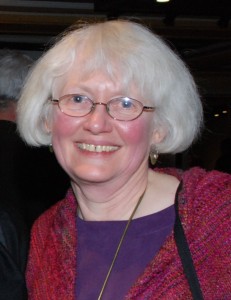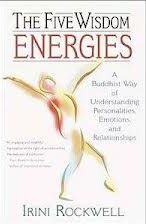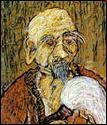Integrating Everything, Excluding Nothing
 Linda Hoka Bebernes, Still Point, 2012
Linda Hoka Bebernes, Still Point, 2012
What do we each bring to expressing the Dharma? This was the theme for the 2012 spring term student program. Through exploring this question, I came to a clearer understanding of how I uniquely express the Dharma, while learning how essential it is to exclude nothing from my practice.
As the framework for exploring this question, we used the Myers-Briggs personality profile and also the five wisdom energies. I was familiar with Myers-Briggs, but the wisdom energies were new to me, so I prepared by reading the two recommended books, Spectrum of Ecstasy by Ngakpa Chogyam and The Five Wisdom Energies by Irini Rockwell. Both associate colors with the different wisdom energies.
As I read Spectrum of Ecstasy, I saw bits and pieces of myself in the various wisdom energies described. However, I didn’t zero in on any particular energy “color” as my dominant color until I encountered “blue” wisdom energy in The Five Wisdom Energies. There I underlined almost every sentence in the author’s five page description of blue energy: mode of operating is mental; interested in a visionary overview but also has a passion for detail, precision, and clarity; has a pacifying, calming effect on others; sees advantages and disadvantages of different positions; and one that particularly jumped out at me…has an inclination to clean up messes, create order, clarify the environment.
In the first session of the term, we each shared a story about when we were “at our best.” To prepare for the second session, we were to reflect on what quality was illustrated by this story and recall other times in our lives that this quality was present. I brought the following story to the second session as an illustration of my blue wisdom energy at its best.
Last summer, my mother-in-law was preparing to move from a large house filled with a lifetime’s collection of possessions into a much smaller apartment. Relatives had come from out of town to help her prepare for the move, but they were far from ready when moving day arrived. When I went to the house to help, it was clear they were in trouble. The moving van had just driven up, half-filled boxes were scattered throughout the house, and my mother-in-law and brother-in-law were teetering on the brink of an argument about what to do next.
They both willingly accepted my offer to “make some suggestions,” so I proceeded to help each family member determine how they could best contribute, suggested a place for the movers to start, and then took my mother-in-law to another part of the house, where we began working through several unpacked rooms. I let her be in control by simply asking her questions … “Where would you like to start?” “What do you want to do with this?” “In which box should we put that?” … until everything was organized and ready for the movers to pack up and load.
Expressions of gratitude from family members and a note later from my mother-in-law thanking me for what she called my “nonjudgmental help” confirmed that I had been “at my best” that day.
For the third session, we were to prepare a presentation that reflected the dharma of who we were. It could be a talk, a work of art, a performance, or whatever we chose. I decided to prepare a short talk, but was stymied about what to say that would be useful. I could talk about what I had discovered, but I was still unclear about how it fit into a broader context. My blue energy self was missing that visionary overview and clarity I needed to pull the talk together.
I decided to return to the book Spectrum of Energy, curious as to why, when I first read this book, I hadn’t connected with blue wisdom energy (which this book assigns the color white).
This book focuses on how the energy types represented by the different colors can become distorted. The way in which a particular energy becomes distorted has to do with how a person relates to intrinsic space or emptiness or, as it is often referred to in this book, our spacious nature. Each type of energy has a characteristic way of becoming distorted in response to the way intrinsic space (emptiness) is experienced. For example, if a person experiences intrinsic space (emptiness) as a sense of lacking substance, they may respond by acquiring things, or if they experience it as a sense of isolation, they may throw themselves into social activities.
 I learned that a person for whom blue energy is dominant may experience intrinsic space (emptiness) as threatening and respond with fear, which then turns into anger and aggression. In my first reading of this chapter, I hadn’t recognized myself as someone struggling with anger and aggression. I was taught at a very young age that a person who expressed anger was “bad,” so, even though I’m aware of feeling angry at times, I rarely express anger directly toward another person and see myself as having a calming influence in the presence of anger.
I learned that a person for whom blue energy is dominant may experience intrinsic space (emptiness) as threatening and respond with fear, which then turns into anger and aggression. In my first reading of this chapter, I hadn’t recognized myself as someone struggling with anger and aggression. I was taught at a very young age that a person who expressed anger was “bad,” so, even though I’m aware of feeling angry at times, I rarely express anger directly toward another person and see myself as having a calming influence in the presence of anger.
After reflecting a bit on what I’d just discovered, I revisited the story of my mother-in-law’s move and found another story waiting:
Earlier that summer, my partner and her sister had anticipated that their mother would need some help organizing her move and asked me if I would help, which I was ready to do. After her new apartment became available, I went with her to scope it out and take measurements. While we were there, I took the opportunity to make suggestions for how we might organize the move in stages to make it easier for her. Each time I brought up the topic, she changed the subject rather than engaging with me. Finally, in the car on the way home, I explicitly offered to help her plan the move.
My mother-in-law is capable of saying “no”, without actually saying “no“, in the most coldly gracious way of anyone I’ve known. I felt quite angry at the way she declined my offer, but took great care not to show it. Later, when I told my partner and her sister that I’d “gotten the treatment” in response to my offer, they knew instantly what I meant. I told them that given her response, I was no longer willing to help her unless she specifically asked. We all agreed that would never happen, so I felt completely justified in stepping aside.
Over time, I heard reports of the chaos developing at the house as moving day approached. Meanwhile, I congratulated myself on the equanimity I was cultivating. It wasn’t my problem. They would have to work it out. I’d done what I could.
Then moving day came and everyone planned to meet at the house that morning to help. As I drove over, I found myself relishing the opportunity to come to the rescue or … do I dare admit it? … to gloat. No hard feelings? No anger? Complete equanimity? Hardly. I was coming to realize that I’d been looking forward to this moment since the instant my offer of help was rejected by my mother-in-law weeks before.
So now I had two stories, which seemed to be about two completely different versions of myself ―although both felt true. As I thought about it, I realized that the first story of bringing calmness and order to a chaotic situation represented a period of time when my blue wisdom energy was flowing freely; and the second story represented a period of time when it was distorted into anger, even as I saw myself being composed and accepting.
I then asked myself, what was the underlying fear that led to my anger in the second story? I view myself as calm, competent, and in control―someone who is able to create order from chaos. When my mother-in-law didn’t reflect that view of myself back to me, I felt fear―fear of being inadequate, unheard, and not in charge―which quickly turned to anger. (And her icy response could very well have come out of a similar fear on her part that she was not being seen by me as capable and competent).
By now, it was becoming clear that the dharma of who I am involves walking that edge between neutral clarity and distortion into fear and anger. I need to be on the alert for the false sense of equanimity that comes from denying or repressing anger. The challenge for me is to fully embrace this emotional aspect of myself while not “indulging” it by either turning it outward toward others or inward toward myself.
My spring term talk was taking shape and I even knew now how I would end it―with a quote from Hongzhi that I had chosen the previous fall term for my mondo practice:
“When you face what you have excluded and see how it appears, you must quickly gather it together and integrate with it. Make it work within your house, then establish stable sitting.”

